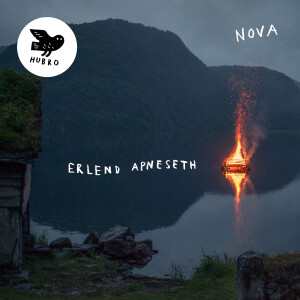 I’m usually not a huge fan of strictly solo instrumental albums, but I can easily overlook that rule of thumb for Erlend Apneseth’s Nova. It’s hard to overstate just how much I enjoy this record. Some of that is simply due to the fact that Apneseth plays the Hardanger fiddle, which has become one of my favorite instruments in the past few years. And that he’s a world-class virtuoso on the Hardanger, Norway’s signature folk instrument. I’m a big fan of the Erlend Apneseth Trio’s recorded works, especially “Salika, Molika,” by the Erlend Apneseth Trio and Frode Haltli, which won the Norwegian equivalent of the Grammy in 2019. (This has been a big year for Hardanger albums on Hubro alone, with Benedicte Maurseth’s Hárr already high on my list of top folk albums; not to mention Nils Økland’s Glødetrådar, which was released late in 2021.
I’m usually not a huge fan of strictly solo instrumental albums, but I can easily overlook that rule of thumb for Erlend Apneseth’s Nova. It’s hard to overstate just how much I enjoy this record. Some of that is simply due to the fact that Apneseth plays the Hardanger fiddle, which has become one of my favorite instruments in the past few years. And that he’s a world-class virtuoso on the Hardanger, Norway’s signature folk instrument. I’m a big fan of the Erlend Apneseth Trio’s recorded works, especially “Salika, Molika,” by the Erlend Apneseth Trio and Frode Haltli, which won the Norwegian equivalent of the Grammy in 2019. (This has been a big year for Hardanger albums on Hubro alone, with Benedicte Maurseth’s Hárr already high on my list of top folk albums; not to mention Nils Økland’s Glødetrådar, which was released late in 2021.
This is Apneseth’s first strictly solo album in nine years, and it seems to be something he truly enjoys. “The Hardanger fiddle is traditionally a soloistic instrument,” he says. “For me, one of the most fascinating things about the instrument is its ability to fill a whole room with sound all by itself. Even though I’ve been working in an electro-acoustic universe the last years, I’ve never left the acoustic approach to the Hardanger fiddle, and I now felt the time had come to do something all alone again.”
Talk about filling up a room with sound! Apneseth chose to record this music in an iconic spot in Oslo, the Emmanuel Vigeland Museum and Mausoleum. Vigeland, an artist who died in 1948, built the structure in 1926 as a future museum for his sculptures and paintings. He eventually decided he wanted it to be his mausoleum, too, and his ashes now rest there, in addition to his art. According to the museum’s website, “The museum’s main attraction is a dark, barrel-vaulted room, completely covered with fresco paintings. The 800 sq.m. fresco Vita depicts human life from conception till death, in dramatic and often explicitly erotic scenes.”
It also has a monster echo that Sam Phillips would’ve killed for, and Apneseth uses it to great effect.
As with so many of the unique artists on the Hubro label (and elsewhere on the Nordic scene) Apneseth is rooted in traditional music, but unites it with a improvisation borrowed from jazz and a curiosity for sonic exploration from the avant garde. The result, especially when united with the sonic possibilities of the recording space and the fiddler’s use of himself as another instrument, is wondrous.
Erlend composed and created all of the 10 pieces of music on Nova except the first “Ly” (Shelter), which is a traditional lyarslått (listening tune). It opens with some ambient sounds as he prepares to play in this echoing tomb, then proceeds through a somber melody. It seems like he’s very much experimenting with sound and space for much of this album. Several tunes begin with an echoing foot stomp, and proceed almost as though he’s improvising on the spot, one tune leading into the next. There’s lots of pizzicato and Darrol Anger style bouncing of the bow on the strings. “Speglingar” (Reflections) sounds almost like it’s played on a hammer dulcimer.
The most traditional sounding track is “Bestemor Bremen” (Grandma Bremen), a lilting tune that blends folk and art song. On the next, an avant garde bit titled “Palmyra,” Erlend occasionally sings wordlessly along with the dissonant plucking and bowing. The most emotional piece is “Til eith Astrup-bilete,” a yearning tune that’s an homage to the Norwegian modernist painter Nikolai Astrup. “Gravsong” is suitably grave, and the set ends with the most experimental track, “Ettertid” (Afterwards).
Like its namesake, Nova is a bit surprising, a bit mysterious, a bit awe-inspiring. Most of all it’s an intensely personal reflection of a musician in deep communion with his instrument.
(Hubro, 2022)
